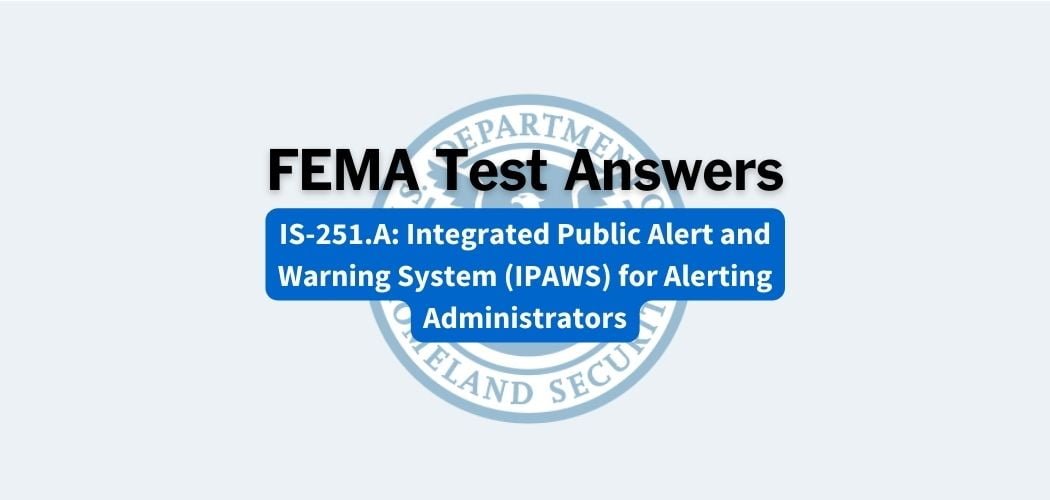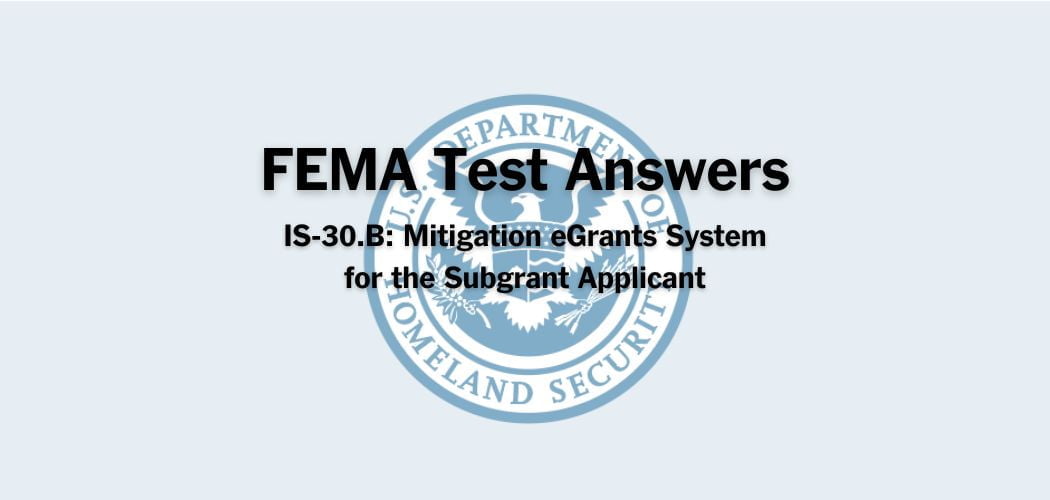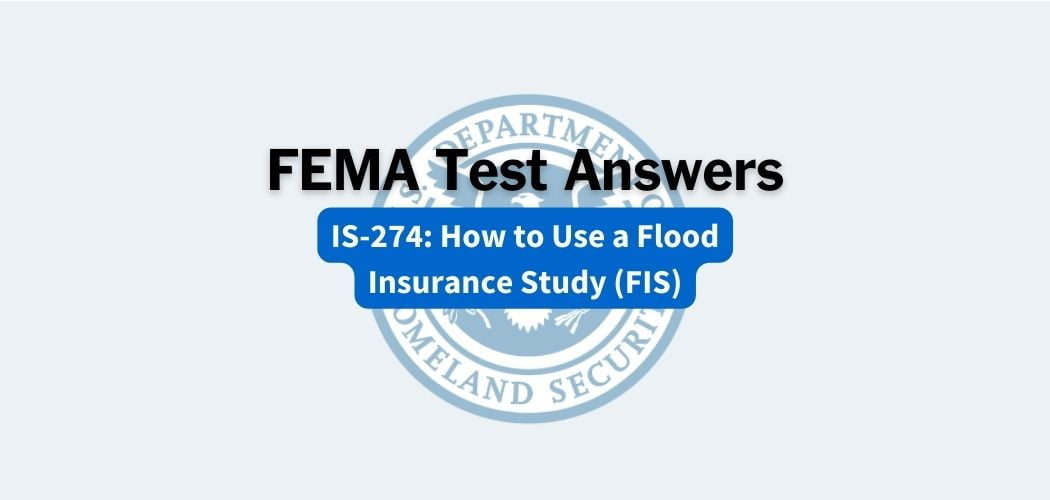Overview: The FEMA IS-323 course was published on 10/31/2013 to train Hazard Mitigation Advisor Specialists to explain both the earthquake hazard and how to mitigate future damages effectively, to people affected by earthquakes.
NOTE: Each time the IS-323 final test is loaded, you will receive a unique set of questions and answers. The test questions are scrambled to protect the integrity of the exam.
FEMA IS-323 test answers
Question 1. The earthquake mitigation measure recommended for a garage door is :
A. Bolt the garage door to the garage frame.
B. Install reinforced garage doors to add to the structural integrity of the structure.
C. Reinforce the narrow wall on either side of the garage door because these walls offer little structural support.✅
D. All of these are recommended.
Question 2. When asked, it is ok to give specific repair directions to the public
A. TRUE
B. FALSE✅
Question 3. Purchasing flood insurance is one way to mitigate financial risk in communities with potential flood hazards from tsunamis or dam/levee failures that may be a secondary impact of earthquakes.
A. TRUE✅
B. FALSE
Question 4. To mitigate damage that can be caused to and by large appliances during earthquakes, which mitigation measure(s) would be recommended?
A. Use flexible connectors between appliances and utility supplies.
B. Install easily accessed shut-off valves at utility supplies for appliances.
C. Use metal straps anchored into studs, chains, or heavy-duty guide wire to secure large appliances or fuel tanks.
D. All of these are recommended.✅
E. None of these are recommended.
Question 5. What is the purpose of hardening a structure by strengthening the continuous load path?
A. The continuous load path connects the roof directly to the bottom floor of a structure, thereby aligning the building and allowing it to withstand forces associated with earthquake shaking
B. By using metal brackets and straps, all of the structure’s components are linked horizontally and vertically so they stay connected when the structure is shaken by an earthquake.
C. By linking and reinforcing connections between each level of a structure, from the roof to the foundation, the load caused by earthquake shaking is transferred to the ground, helping to pr
D. All of these are correct.✅
Question 6. FEMA-recommended publications can be found at FEMA.gov and :
A. FLASH
B. ICC
C. USGS
D. HM Disaster Workforce Website✅
E. IBHS
Question 7. Keeping tools to shut off utility supplies near the shut-off valves in not recommended.
A. TRUE
B. FALSE✅
Question 8. Loss of electrical power and fires are secondary impacts of earthquake damage
A. TRUE✅
B. FALSE
Question 9. Which publication(s) below should you recommend to the members of the general public in a community that is at risk of earthquakes?
– Reducing the Risks of Nonstructural Earthquake Damage: A Practical Guide Third Edition
– Techniques for the Seismic Rehabilitation of Existing Buildings (FEMA 547)
– FEMA Earthquake Basics: Science, Risk and Mitigation (IS-325)
– The QuakeSmart Toolkit (FEMA P-811)
– Protect Your Property from an Earthquake
A. 1), 3, and 5).
B. Only 5).
C. 2), 3), and 4).
D. All of these are recommended for the general public.✅
Question 10. Which FEMA-partner organization(s) below would you recommend to the public for information on mitigating damage from earthquakes?
A. IBHS
B. FLASH
C. USGS
D. All of the above.✅
Question 11. What mitigation measures would you recommend for securing cabinet doors or drawers?
A. Use chains or Velcro to secure the doors.
B. Use child safety latches and store incompatible chemicals in low cabinets.✅
C. Use double-sided tape around the edges of the door and drawer.
D. All of these are recommended.
Question 12. What mitigation measures would you recommend for securing loose electronic items such as television sets, computer monitors, and electric appliances?
A. Use chains, straps, bungee cords, or Velcro.✅
B. Use child safety latches.
C. Use flexible connectors.
D. All of these are recommended.
Question 13. A masonry chimney should be braced with horizontal metal straps every few feet against the structure and into reinforced points such as wall studs to stabilize the chimney from the shaking force of an earthquake.
A. TRUE✅
B. FALSE
Question 14. Anchoring large furniture items can reduce the possibility of injury to people, damage to other items, and reduce the possibility that these items may block escape routes.
A. TRUE✅
B. FALSE
Question 15. Directing the public to building officials before repairs or rebuilding begins provides an opportunity for the building official to state that only licensed professionals are qualified to perform structural repairs or structural mitigation work.
A. TRUE✅
B. FALSE
Question 16. The type of soil on which a structure is built cannot contribute to the structural damage caused by an earthquake.
A. TRUE
B. FALSE✅
Question 17. The connections along the continuous load path are roof, to lower walls, to main floor to foundation.
A. TRUE✅
B. FALSE
Question 18. When advising the public about earthquake mitigation, which action below is the BEST to take?
A. Google “rebuilding homes after an earthquake, and provide a list of websites.
B. Offer all FEMA publications that give explicit instructions for rebuilding after an earthquake.
C. Refer to appropriate FEMA-approved publications and websites, and recommend speaking with local building officials.
D. Explain mitigation techniques from your own experiences.✅
E. All of the above.
Question 19. During an earthquake, earth shifting can cause a levee or dam to break allowing water to flood adjacent areas. However, flood insurance does not reduce financial risks associated with this type of flooding.
A. TRUE
B. FALSE✅
Question 20. Which publication(s) below should you recommend to the building or design professional working in an earthquake-affected area?
– Rapid Visual Screening of Buildings for Potential Seismic Hazards (FEMA 154)
– Pre-standard and Commentary for the Seismic Rehabilitation of Buildings (FEMA 356)
– Techniques for the Seismic Rehabilitation of Existing Buildings (FEMA 547)
A. Only 1
B. Only 3
C. Only 1 and 2
D. All of these are recommended for the building and design professionals✅
Question 21. Since an earthquake cannot affect coastal communities, there is no need for people living in coastal communities to purchase flood insurance.
A. TRUE
B. FALSE✅
Question 22. Broken sewer lines and water mains are secondary impacts of earthquake damage.
A. TRUE✅
B. FALSE
Question 23. Why should HM staff direct the public to local building officials before repairs to earthquake-damaged properties begin?
A. FEMA staff does not make any recommendations at all.
B. Building officials always require the use of licensed professionals to do the repairs.
C. The community may have a floodplain ordinance, a building code, and/or other requirements for rebuilding.✅
D. None of these are correct.
Question 24. Construction materials and constructions methods used can contribute to the structural damage caused to a structure by an earthquake
A. TRUE✅
B. FALSE
Other Hazard Mitigation answers
This module is one in a series of Independent Study modules for the Hazard Mitigation disaster workforce, which addresses appropriate basic mitigation information for public consumption regarding earthquakes, floods, hurricanes, tornados, and wildfires.
![[FEMA Test Answers] IS-5.A: An Introduction to Hazardous Materials - Test Pinoy](https://testpinoy.com/wp-content/uploads/2021/11/fema-is-5a.jpg)


